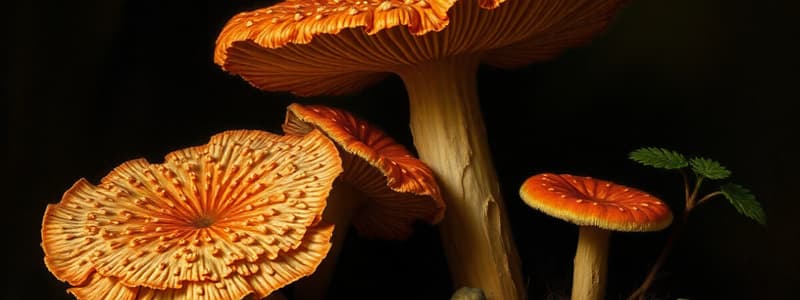Podcast
Questions and Answers
What are the characteristics of fungi?
What are the characteristics of fungi?
Achlorophyllous, Eukaryotic, Heterotroph, filamentous, reproduce mainly by spores.
Which of the following is a characteristic of plant pathogenic fungi?
Which of the following is a characteristic of plant pathogenic fungi?
- They are prokaryotic.
- They reproduce only sexually.
- They possess chlorophyll.
- They are heterotrophic. (correct)
Plant pathogenic fungi are eukaryotic organisms.
Plant pathogenic fungi are eukaryotic organisms.
True (A)
Plant pathogenic fungi reproduce mainly by ______.
Plant pathogenic fungi reproduce mainly by ______.
What is the nutrition method of plant pathogenic fungi?
What is the nutrition method of plant pathogenic fungi?
Describe the vegetative thallus structure of fungi.
Describe the vegetative thallus structure of fungi.
What is typically present in the cell wall of fungi?
What is typically present in the cell wall of fungi?
Which of the following is a phylum under Kingdom Fungi?
Which of the following is a phylum under Kingdom Fungi?
What are the motile cells formed by Chytridiomycota called?
What are the motile cells formed by Chytridiomycota called?
What is the primary plant disease caused by Olpidium brassicae?
What is the primary plant disease caused by Olpidium brassicae?
Zygomycetes produce zoospores.
Zygomycetes produce zoospores.
What kind of spores are produced by Ascomycota?
What kind of spores are produced by Ascomycota?
The imperfect fungi in Phylum Ascomycota are known as ______.
The imperfect fungi in Phylum Ascomycota are known as ______.
What is the defining characteristic of the class Zygomycetes?
What is the defining characteristic of the class Zygomycetes?
Flashcards are hidden until you start studying
Study Notes
Plant Pathogenic Fungi
- Achlorophyllous: Lack chlorophyll, meaning they cannot photosynthesize and must obtain food from other sources.
- Eukaryotic: Possess a nucleus enclosed within a membrane.
- Heterotroph: Obtain their nutrition from organic matter, either living or dead.
- Reproduce mainly by spores: Can reproduce both sexually and asexually through spore formation.
- Nutrition by absorption: They absorb nutrients from their environment through specialized structures.
- Spore-forming microorganisms with branched filamentous vegetative structures: Have a characteristic filamentous structure called hyphae, which can be branched.
- True nuclei and cell walls: Possess a nucleus and cell walls, which are primarily composed of chitin.
- Cell wall: Typically consists of glucans and chitin (Eumycota) or glucans and cellulose (Oomycota/ Stramenopila).
- Eukaryotic, uni- or multinucleate thallus: Can have one or multiple nuclei within their body, which can be haploid, dikaryotic or diploid.
- Vegetative thallus is typically a filamentous nonmotile mycelium or hyphae: Their body is made up of a network of hyphae, which are filamentous structures without the ability to move.
- Hyphae can be coenocytic or septated: Hyphae can be either continuous with multiple nuclei (coenocytic) or divided into individual cells with septa (septated).
Studying That Suits You
Use AI to generate personalized quizzes and flashcards to suit your learning preferences.




